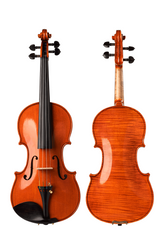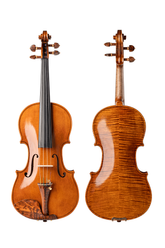Analysis of Emotional Characteristics in Paganini's Violin Works

Niccolò Paganini, a renowned figure in the world of classical and romantic music, is celebrated as one of the most prominent violinists and composers of his era.
He not only showcased the highest level of violin performance and composition during his time but also infused his works with rich emotional depth.
Historically, Paganini's legacy has predominantly focused on his virtuosic playing, with less attention given to his compositions.
In this article, we will explore the emotional characteristics of Paganini's compositions and summarize the factors contributing to their formation.
I. Overview of Paganini's Violin Compositions
Born in 1782 in the picturesque Italian town of Genoa, Niccolò Paganini was a remarkable composer and virtuoso violinist. His early exposure to music, including his debut performance of self-composed works at the age of nine and his formal training under the guidance of Pasquale Paër, the director of the Parma Music Academy, marked the beginning of a lifelong journey in music. Throughout his illustrious career spanning over half a century, Paganini made significant contributions to various aspects of violin performance, instrument development, and composition. While his virtuosic abilities often take center stage in discussions about his life, his compositions deserve equal recognition. Paganini's body of work, which includes 24 Caprices and five violin concertos, is abundant in both quantity and quality. Although his pieces occasionally display elements of technical prowess, they are also replete with intellectual and artistic merit.
II. Analyzing the Emotional Characteristics in Paganini's Violin Compositions
1. Heroism
Niccolò Paganini was a prominent figure during the era of European Romanticism, which emphasized breaking free from traditional constraints and prioritizing emotional expression in music. His compositions reflect a sense of heroism, as he likened himself to a warrior using his compositions as weapons to challenge the existing norms.
Firstly, he incorporated march-like motifs into his works. Among the 24 Caprices, one piece is dedicated entirely to a march, using a distinct 4/2 time signature in E-flat major. This march, characterized by its concise and rhythmically charged structure, is filled with a sense of momentum and vitality. As the Italian revolution gained momentum, Paganini continued to use march-like motifs in his compositions. In his five violin concertos, he employed similar techniques, creating an atmosphere reminiscent of a military battle, with its vigorous and grandiose qualities.
Secondly, Paganini's ability to emulate the sound of trumpets is notable. Often referred to as a "wizard," he had a remarkable talent for mimicking various sounds using the violin. Trumpets in the context of war symbolize advancement and charge, serving as an uplifting force. Paganini, in several compositions, imitated the timbre of trumpets, further emphasizing the heroism he aimed to convey. For instance, in the 18th Caprice from the 24 Caprices, the piece opens with a G-string passage employing a 6/8 waltz rhythm. Through ornamentation and powerful, staccato bowing, he mimicked the sound of a trumpet. The 23rd Caprice featured a French horn imitation, symbolizing the arrival of victory. Paganini employed this emulation of trumpet sounds in various sections of his violin concertos, such as in the first, fourth, and fifth concertos. Through rhythmic and melodic variations, he portrayed scenes of military valor, leaving a significant impact on later composers like Berlioz and Liszt.
Lastly, a sense of grandeur was a prominent feature of Paganini's compositions. The term "maestoso," which signifies "majestic" and "solemn" in musical expression, aligns with the heroic emotion he pursued. In his five violin concertos, all the first movements adopt the emotional shading of "maestoso." Paganini was acutely aware of the conflicts and wars of his time, and his compositions were far from mere emotional outbursts; they were deliberate attempts to inspire and motivate people. The pursuit of heroism in his work held significant implications for the era, advocating for progress and change.
2. Melancholy
Paganini's unique upbringing, marked by a shadowy childhood, constant touring, and upheavals, left an indelible mark on his compositions, which frequently displayed a sense of melancholy. For a period, he even ceased all creative and performing activities, living a reclusive life. His compositions bear the unmistakable mark of this melancholic nature.
Firstly, he made extensive use of slow movements in his compositions. In each of his five violin concertos, the second movements are composed as slow or "languid" pieces. These movements contrast with the exhilarating and triumphant first movements, often conveying a sense of introspection and calmness. Critics at the time noted that Paganini's second movements were deliberately simple, devoid of the virtuosic complexities present in other parts of his works. It is evident that Paganini's intention went beyond mere technical display; he aimed to evoke a new emotional experience through the use of slow movements. In these segments, the solo violin takes the forefront, and the orchestra's role becomes more of a backdrop, akin to fleeting sighs and whispered confessions, beautifully complementing the violin's expression of melancholy and sorrow.
Secondly, Paganini was highly devoted to the art of vocal melodic lines. Even though he was a violinist, he held the belief that the human voice produced the most beautiful and emotional tones. Coming from Italy, the birthplace of bel canto, the art of beautiful singing, Paganini drew significant inspiration from this tradition. As a result, his compositions often feature melodies resembling those of a singer, especially in the slow movements of his five violin concertos. These slow movements are characterized by extended, lyrical melodies with strong lyricism, flowing in an undulating and uninterrupted manner. They evoke the sentiment of a passionate vocal performance, leaving the listener with a profound and exquisite experience. The melancholic characteristic of his work finds its fullest expression in these lyrical and vocal-like segments.
3. Joy
Paganini's compositions are a blend of melancholy and joy, coexisting to create a rich emotional palette. He displayed a deep appreciation for dance music and the sound of bells, adding elements of cheerfulness to his works.
Firstly, his love for dance music is evident in his compositions. In his five violin concertos, he skillfully incorporated lively dance melodies and variations. These exuberant and spirited dance rhythms, accompanied by colorful variations, often introduce a sense of comedy into the compositions. This light-hearted and hopeful tone replaces the earlier melancholic emotions, symbolizing a brighter future. The final movements of Paganini's concertos, such as the closing scene of his first concerto, depict festive dance scenes, where themes carry a playful and humorous quality. Paganini's ability to transition from one emotional landscape to another showcases the depth and versatility of his compositions.
Secondly, Paganini had a deep affection for the sound of bells, which frequently appeared in his work. Celebratory bell sounds, often at the beginning of movements, were interwoven with the solo instrument. These bell-like chimes, along with trumpet imitations and lively dance rhythms, create a light and vibrant atmosphere in his compositions, symbolizing the dawning of victory and unity. For instance, triumphant bell sounds are featured after his rondo movements, where the orchestra's volume swells, and the ringing melodies gain intensity, building to a climactic finale. Paganini's compositions carry an air of jubilation and the promise of a bright future.
In conclusion, Niccolò Paganini celebrated as one of the most prominent figures in the history of violin performance and composition, left a multi-faceted legacy. While he revolutionized violin technique and expanded the expressive possibilities of the instrument, he also enriched the world of music with a diverse body of compositions. Notably, his pursuit of emotional depth and the interplay between heroism, melancholy, and joy in his works had a profound impact on the Romantic era of music. This exploration of the emotional aspects of his compositions serves to provide a deeper understanding of his works, enhancing the appreciation and performance of his music.
Paganini's influence continues to resonate through the ages and across borders, making his contribution to music a timeless treasure.
Note: The pictures in this article come from Wikipedia





